| کد مقاله | کد نشریه | سال انتشار | مقاله انگلیسی | نسخه تمام متن |
|---|---|---|---|---|
| 518423 | 867587 | 2014 | 19 صفحه PDF | دانلود رایگان |
Computational models based on a fluid description of the plasma, such as magnetohydrodynamic (MHD) and extended magnetohydrodynamic (XMHD) codes are highly efficient, but they miss the kinetic effects due to the assumptions of small gyro radius, charge neutrality, and Maxwellian thermal velocity distribution. Kinetic codes can properly take into account the kinetic effects, but they are orders of magnitude more expensive than the fluid codes due to the increased degrees of freedom. If the fluid description is acceptable in a large fraction of the computational domain, it makes sense to confine the kinetic model to the regions where kinetic effects are important. This coupled approach can be much more efficient than a pure kinetic model. The speed up is approximately the volume ratio of the full domain relative to the kinetic regions assuming that the kinetic code uses a uniform grid. This idea has been advocated by [1] but their coupling was limited to one dimension and they employed drastically different grid resolutions in the fluid and kinetic models.We describe a fully two-dimensional two-way coupling of a Hall MHD model BATS-R-US with an implicit Particle-in-Cell (PIC) model iPIC3D. The coupling can be performed with identical grid resolutions and time steps. We call this coupled computational plasma model MHD-EPIC (MHD with Embedded PIC regions). Our verification tests show that MHD-EPIC works accurately and robustly. We show a two-dimensional magnetosphere simulation as an illustration of the potential future applications of MHD-EPIC.
Journal: Journal of Computational Physics - Volume 268, 1 July 2014, Pages 236–254
